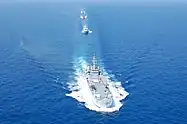 INS Airavat (L24) sails out of Visakhapatnam harbour after commissioning | |
| Class overview | |
|---|---|
| Name | Shardul class |
| Builders | Garden Reach Shipbuilders and Engineers |
| Operators | |
| Preceded by | Magar class |
| Completed | 3 |
| Active | 3 |
| General characteristics | |
| Type | Tank landing ship |
| Displacement | 5,650 tons |
| Length | 125 m (410 ft) |
| Beam | 17.5 m (57 ft) |
| Draught | 4 m (13 ft) |
| Propulsion | Kirloskar PA6 STC engines |
| Speed | 16 kn (30 km/h; 18 mph) |
| Capacity |
|
| Troops | 500 |
| Complement | 11 officers, 145 sailors |
| Electronic warfare & decoys | Decoy: Chaff launchers |
| Armament |
|
| Aircraft carried | 1 Sea King/HAL Dhruv |
Shardul-class landing ships are large amphibious warfare vessels built at Garden Reach Shipbuilders and Engineers for the Indian Navy. They are an evolution of the Magar-class amphibious landing ships.
The class has an indigenous content of over 90%.
History
Shardul was the first vessel commissioned at Karwar Naval Base, INS Kadamba. The second ship Kesari was commissioned at the Visakhapatnam Naval Base,[1] and later moved to Port Blair.[2] The third ship Airavata underwent sea trials in 2008 and was commissioned in 2009.[3][4][5]
Ships
| Name | Pennant Number | Commissioned | Decommissioned | Homeport | Status |
|---|---|---|---|---|---|
| Shardul | L16 | 4 January 2007 | Karwar | Active | |
| Kesari | L15 | 5 April 2008 | Port Blair | ||
| Airavat | L24 | 19 May 2009 | Visakhapatnam | ||
Gallery
See also
References
- ↑ "INS Kesari Commissioned". Indian Navy. 5 April 2008. Archived from the original on 21 June 2008. Retrieved 6 July 2019.
- ↑ "Another naval ship heads for Seychelles". The Hindu. 8 May 2009. Retrieved 21 February 2015.
- ↑ Balajj, J. (8 April 2008). "INS Airavata for basin trials in May". The Hindu. Archived from the original on 29 April 2012. Retrieved 21 February 2015.
- ↑ "Image of INS Airavat". Press Information Bureau. Government of India. 19 May 2009. Retrieved 21 February 2015.
- ↑ "Image during Commissioning ceremony". Press Information Bureau. Government of India. 19 May 2009. Retrieved 21 February 2015.
External links
Wikimedia Commons has media related to Shardul class landing ships.
This article is issued from Wikipedia. The text is licensed under Creative Commons - Attribution - Sharealike. Additional terms may apply for the media files.
_entering_Port_Luis%252C_Mauritius.jpg.webp)
_of_1st_Training_squadron_en-route_to_Sri_Lanka.jpg.webp)

